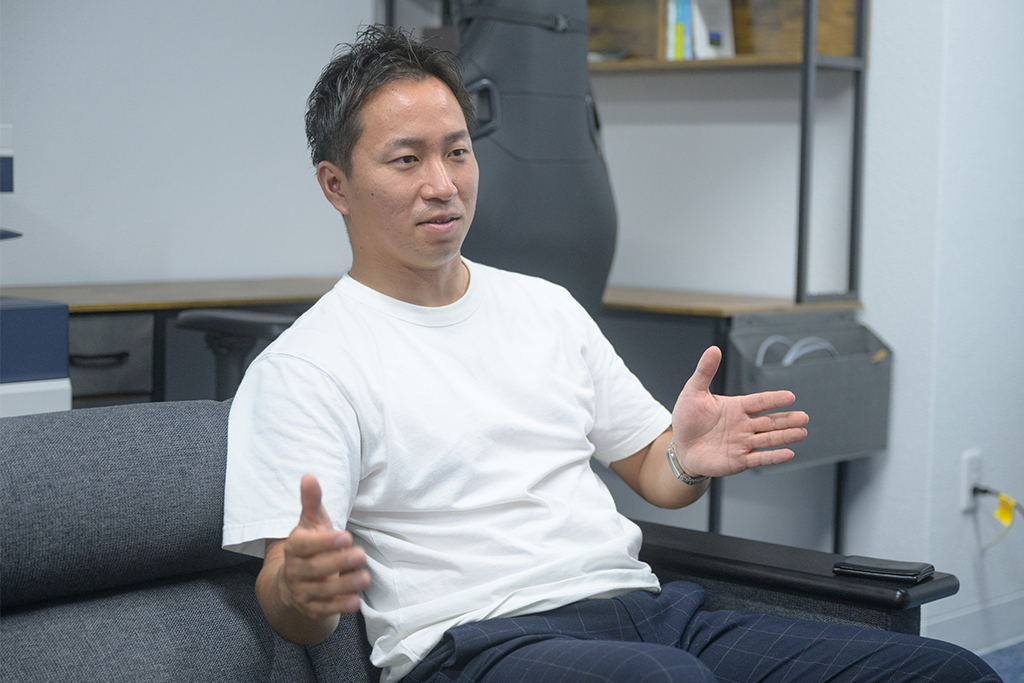Note: This website was automatically translated, so some terms or nuances may not be completely accurate.
From Iki to the World: Regenerating Seaweed with Artificial Reefs "Reef Balls" to Revive Abundant Fishing Grounds (Part 2)

Hisanori Tayama
General Incorporated Association Marine Habitat Iki

Koji Fuji
Dentsu Inc.
The artificial reef "Reef Ball" is gaining attention as one blue carbon initiative to combat global warming. Working alongside Mr. Osamu Ikeda, President of Asahi Tech Co., Ltd., in Nagasaki Prefecture to promote its adoption is Mr. Hisanori Tayama, Representative Director of the General Incorporated Association Marine Habitat Iki.
Reef Balls are not only for climate change mitigation; by regenerating seaweed, they are expected to enrich marine resources and revitalize fisheries and various industries. In Part 2, we hear from Mr. Tayama about his vision for revitalizing Iki City. Additionally, Mr. Takashi Fujii of Dentsu Inc. spoke with people in Iki engaged in seaweed bed restoration through Reef Ball demonstration experiments.
The Impact of Blue Carbon Initiatives on Iki's Industries

Field Tests of Reef Balls and Seaweed Bed Restoration Activities Across Iki
After this interview, we were shown two locations where Leaf Ball demonstration experiments are underway. The first is the former Shinozaki Fishing Port, once used as a fishing harbor. The fishing cooperative has now fenced off this unused area with nets to keep algae-eating fish out, installing Leaf Balls to conduct seagrass bed restoration experiments. We also spoke with Mr. Akira Yamakawa, Section Chief of the General Affairs Department at the Hakozaki Fisheries Cooperative, who is collaborating with Mr. Tayama.


The other location is Iki Dolphin Park & Resort. We were shown the Leaf Ball experiment being conducted in the pool of this leisure facility, where visitors can interact with dolphins, by Mr. Yoshitake Takada, President of IKI PARK MANAGEMENT Co., Ltd., the facility's operator.


It's not just Mr. Tayama; many people on Iki are working on restoring seaweed beds. We can only hope these efforts bear fruit and that the rich seas return to Iki as soon as possible. And perhaps the initiatives on Iki will spread nationwide as a model case, contributing to the revival of marine resources throughout Japan.

Mr. Tayama's passion, which extends beyond just fisheries to revitalizing Iki's entire industry, is spreading. More people are supporting the reef ball initiative. If more demonstration experiments succeed, bringing back rich fishing grounds to Iki and reviving its fisheries, it could lead to the revival of marine resources throughout Japan and the world.
The information published at this time is as follows.
Was this article helpful?
Newsletter registration is here
We select and publish important news every day
For inquiries about this article
Author

Hisanori Tayama
General Incorporated Association Marine Habitat Iki
Representative Director, Asahi Tech Co., Ltd. Project Manager
Born May 13, 1991, in Iki City, Nagasaki Prefecture. Graduated from Nihon Bunri University's Faculty of Business and Economics. Played baseball for the university's varsity team during his student years. Currently enrolled at the Graduate School of Business and Innovation. At age 30, driven by a desire to "contribute to the island," he decided to return home. Inspired by his encounter with Leaf Ball, he established the General Incorporated Association Marine Habitat Iki with the goal of overcoming "seabed desertification" (iso-yake). From his hometown of Iki Island, he is challenging himself to create a role model for solving serious marine environmental issues.

Koji Fuji
Dentsu Inc.
Marketing Division 7, Solution Production Division 1
Chief Innovation Director
As a specialist in the environment and energy sector, I have been part of Dentsu Inc.'s cross-organizational unit DEMS for over 10 years, responsible for business development with domestic and international energy companies and startups. Since 2019, I have led the decarbonization and carbon neutrality domain, establishing "dentsu carbon neutral solutions" to coordinate and deliver group-wide carbon neutrality solutions and initiatives. Collaborated with internal and external members to develop behavioral change knowledge for decarbonized lifestyles using behavioral economics (nudge techniques) with the Ministry of the Environment, and to advance the Blue Carbon Project addressing coastal desertification—a critical issue for Japan as a maritime nation. Currently working daily toward the goal of positioning the 2025 Osaka-Kansai Expo as the "Ocean Expo," showcasing Japan's unique initiatives to the world.

